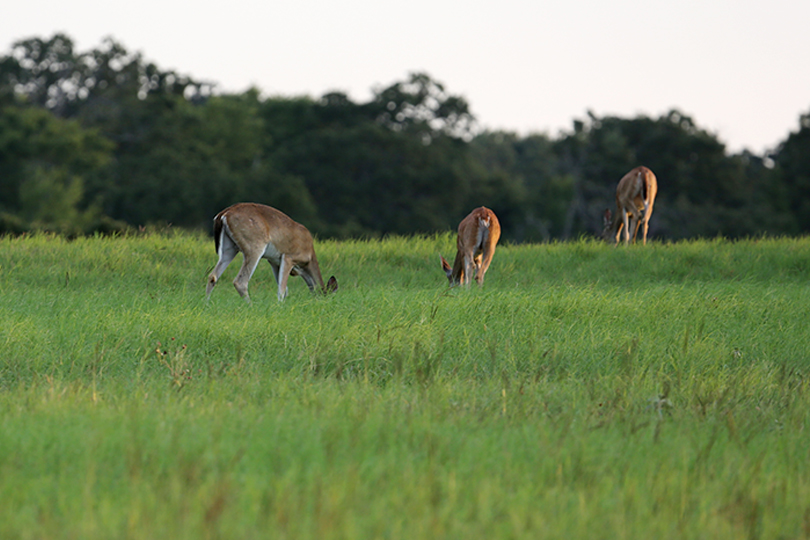By Jennifer Whitlock
Field Editor
Enrollment for the 2021-22 hunting season is now open for the Texas Parks & Wildlife Department (TPWD) Managed Lands Deer Program (MLDP).
The voluntary program is intended to support sound management and stewardship of native wildlife and wildlife habitats on privately-owned Texas lands. It’s a mutually beneficial arrangement for the landowners, said Alan Cain, TPWD White-tailed Deer Program leader.
“As a participant in the program, landowners enjoy the benefits of an extended deer hunting season and, in some cases, enhanced or customized bag limits specific to that particular property,” he said. “But for the department, it gives us access and opportunity to work with landowners across the state on a large scale. We’re able to monitor deer harvest, which is an important aspect of habitat and management and conservation. Too many deer on the landscape can cause impacts to native vegetation, which impacts habitat for other wildlife whether that be wild turkey, quail, Texas horned lizards or songbirds. So, keeping deer numbers in check works to the good of everything.”
New this year are enrollment fees for landowners, which Cain said will be used to hire additional biologists to support the program. He noted the fees became necessary after a substantial increase in program participation over the past 20 years.
“Back when MLDP started, we had about 80 biologists working with the program and about 800 properties enrolled. Fast-forward to today, and we had the same number of biologists but around 12,000 enrollments,” he said in an interview with the Texas Farm Bureau Radio Network. “We were at the point where we weren’t providing the level of service we needed to landowners, as well as to be able to accomplish everything else our staff needed to do. So, we had to find a way to provide additional funding to support new staff to keep providing the same level of service and technical guidance our landowners need.”
The fees vary based upon the option selected at enrollment and how many properties the landowner enrolls.
Landowners may choose one of two options: conservation or harvest.
The harvest option is what Cain called “self-service.” Landowners enroll online to receive deer harvest recommendations, tag issuance and general guidance about wildlife and wildlife habitat management. He said participation in the harvest option provides longer seasons and enhanced bag limits with minimal TPWD involvement, but landowners do not receive technical assistance from TPWD wildlife biologists.
“For the harvest option, there are no real requirements or prerequisites to get into the program. You just need to log in, create an account in our land management assistance (LMA) online system,” Cain said. “Once you create an account, you’ll have to draw your property boundaries out, and then you can enroll in MLDP.”
The fee for the harvest option is $30 per property or management unit and $30 for an aggregate site. Tags can only be issued for white-tailed deer under the harvest option.
The conservation option fee is $300 for the first management unit and $30 for each additional management unit, or $300 for an aggregate site.
Under aggregate acreage properties, multiple landowners may combine contiguous tracts of low-fenced properties to create an aggregate site for enrollment. Each landowner is required to create an LMA account online, provide TPWD a map of their property boundaries and acknowledge consent for their properties to be part of the aggregate acreage. MLDP tags issued to aggregate sites may be used on any tract of land within the aggregate acreage.
“One thing to note is the conservation option has some prerequisites to enroll. You must have two years of data on previous deer population and harvest numbers, and you must have conducted two habitat management practices in each of the two most recent years prior to the year that you’re seeking enrollment,” Cain said. “Once you’re enrolled, you must conduct three habitat management practices every year. Deer harvest may count as one of those practices, but that has to be worked out with your biologist beforehand.”
To remain enrolled in MLDP under the conservation option, landowners must provide TPWD with the current year’s deer population numbers and report harvests at the end of the season.
“Landowners benefit tremendously from the MLD program and the flexibility it provides. It gives them some flexibility to manage deer herds outside of the county’s season and bag limit. It offers that extended season and, in most cases, some sort of liberalized harvest opportunities, or at least site-specific bag limits for a property,” he said. “Under the conservation option, we can also issue tags for both white-tailed and mule deer depending on where the property is at in the state.”
The MLDP season runs about five months, from around the first of October through the end of February. Cain said participants enrolled in the harvest option may hunt antlerless deer for the entire season and may be taken by any lawful means, including modern firearms. During the first month of the MLDP season, bucks with at least one unbranched antler may be taken by any lawful means, including modern firearms. Any other buck during the first month of the season may be taken only with lawful archery equipment. From November until the end of the MLDP season, any buck deer may be taken by any lawful means, including modern firearms.
Click here for more information on MLDP.
A press release explaining the fee structure in detail is also available.


How can I sign up for the MLDP program? The site this link refers me to is not active. Please send me the information. Thanks
Hi. You can find more information about MLDP on the TPWD website at https://tpwd.texas.gov/business/permits/land/wildlife_management/mldp/.